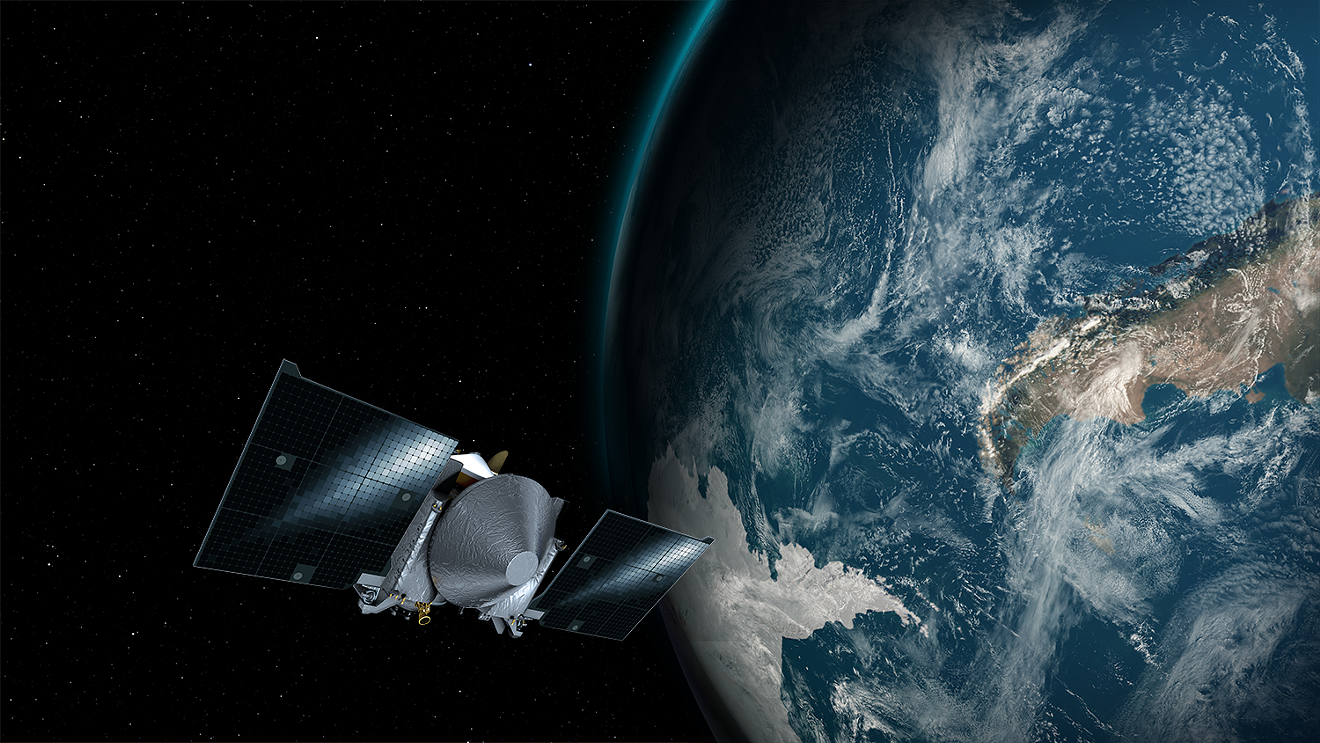Then there was an audible shriek.
"We began to see our beautiful world,” Lauretta said during a press conference Tuesday.
This was no textbook image of Earth. It was taken by a University of Arizona-produced camera built into an asteroid-hunting spacecraft called OSIRIS-REx. It’s pronounced: Oh-Cyrus (like Miley)-Rex (like the Tyrannosaurus). The space-circling robot is the brainchild of Lauretta and his national team of researchers, engineers, scientists, and staff.
The spacecraft’s ultimate goal is to reach an asteroid called Bennu in August of next year. In 2020, the bot will collect gravel from the asteroid, which is about as tall as the Empire State Building and wide as five football fields. If all goes as planned, the craft will then return home to Earth, landing somewhere in Utah in 2023 in the United States' first attempt to bring back a piece of an asteroid for data analysis.
Japan has already reached an asteroid, bringing back only a few specs of dust, said Lauretta, the project’s principal investigator.
And on Friday, OSIRIS-REx came closer to Earth than it had since its launch a year ago. It used the home planet’s gravitational force to slingshot itself out into
OSIRIS-REx came within 10,711 miles of Antarctica and then proceeded north over the Pacific Ocean to propel itself above the Earth.
While they were in the neighborhood, the OSIRIS-REx team members used the Earth flyby to test and calibrate the instruments on their craft.
Over the next two weeks, three of the spacecraft’s instruments will turn on and scan the Earth and Moon.
When the first photo of Earth came in clear, Lauretta said this was a sign that their mission was on track for success.

OSIRIS-REx Principal Investigator Daunte Lauretta and Deputy Principal Investigator Heather Enos discuss the spacecraft's Earth flyby in Tucson on Tuesday, September 26.
Molly Longman
Sara Knutson, the team’s science operations lead engineer, said the photo took her breath away.
“I had chills,” she said. “I knew I had helped build the products that took those images… It feels like it’s your eyes up there in space looking at the Earth.”
While OSIRIS-REx runs on solar power and gravitational pushes from Earth, the team that operates it runs on passion.
Knutson likens the space project team to a bunch of Type-A scholars co-parenting one baby and doing everything in their power to make sure it succeeds in life.
“We all hold a sense of responsibility for making sure we can achieve the main mission objective of bringing back a sample,” Knutson says. “I imagine it’s like having a child, where you wake up and think, “How is the spacecraft doing? I want to look at the data, and make sure everything’s okay. You feel
Lauretta takes this analogy a step further.
During the Earth flyby, there was a planned hour-long blackout period during which Lauretta’s team couldn’t communicate with the spacecraft because it would be too close to Earth for the antennas that were made to function deep in space.
As a father of 8- and 10-year-old boys, Lauretta likened being out of touch with his spacecraft to leaving his children home alone for the first time.
“Even though you’re only running up to the grocery store for 20 minutes and back, the whole time you’re just thinking about: ‘Are they safe? What are they doing? Are they scared? Do I need to get back right now or can I actually pay for this gallon of milk?’” he said. “Those two things were happening in my life at the same time and it’s a very similar kind of feeling. It’s like we know the spacecraft is fine and we know the kids are fine. They’re probably just watching cartoons.”

A color composite image of Earth taken on September 22 by the MapCam camera on NASA’s OSIRIS-REx spacecraft. This image was taken just hours after the spacecraft completed its EarthGravity Assist at a range of approximately 106,000 miles.
NASA/Goddard/University of Arizona
He’s even made award-winning board games about the solar system and constellations.
But, for Lauretta, this adventure isn’t just about interest and curiosity — it’s also about courage.
He became the principal investigator of the project when his friend and mentor, Michael Drake, got sick and later passed away from complications from cirrhosis after a liver transplant,
The two scientists began working together on the ambitious OSIRIS-REx project in 2004, and Drake passed the asteroid-exploration baton to Lauretta.
“Mike’s passing was probably the hardest day of my life, “ Lauretta said. “He was like a father. He really believed in me and he empowered me. I wasn’t even sure I could do something like this until he kind of took me under his wing and we worked together. He boosted my confidence.”
A few days before Drake passed away in 2011, Lauretta said he sat at the bedside of the former director of the University of Arizona Lunar and Planetary Laboratory and head of the planetary sciences department.
He told Drake he didn’t know if he could succeed with OSIRIS-REx without him.
“He told me I could,” a teary-eyed Lauretta said. “ I carry that with me every day.”
Lauretta says he’ll dedicate the asteroid sample-return to Drake.
That’s part of why Lauretta’s itching for the spacecraft to make
And the first images of Earth got Lauretta more excited about all the geeking out he’ll be doing in the years to come.
Although the image of Earth was beautiful, it didn’t come in perfectly, but with little black icicles at the top. That’s because of the camera’s short, roughly-three-millisecond exposure times. They’re made to be short so they can take photos of a dark asteroid, which is why an entity as bright as earth made for an imperfect subject.
Still, Lauretta said the photograph was a thrilling omen for what lies ahead on the voyage to Bennu.
“It felt like I was actually in space and looking at the image,” Lauretta said. “OSIRIS REx is us.”











